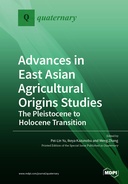Explore

Advances in East Asian Agricultural Origins Studies: The Pleistocene to Holocene Transition
0 Ungluers have
Faved this Work
Login to Fave
Scientific understanding about domestication and the origins of food production in East Asia is undergoing rapid change based on new data from archaeology, paleobiology, and paleoenvironmental studies. The earliest agricultural and pastoral societies emerged from the highly diverse habitats and Paleolithic cultures of East Asia. This offers an unprecedented opportunity to understand and predict variability in the tempo and mode of the Paleolithic to Neolithic transition. Advances in East Asian Agricultural Origins Studies: The Pleistocene to Holocene Transition aims to present the most advanced research from varied regions of East Asia, with the purpose of evaluating the significance of Paleolithic cultural influences on the transition to Neolithic adaptations by comparing cultural evolutionary scenarios through time and across space. The array of approaches will be multidisciplinary, featuring quantitative, qualitative, and integrated data and methodologies. Understanding the transition from foraging to Neolithic agriculture, which was among the most dramatic and influential in the history of modern Homo sapiens, has ramifications for the study of Late Quaternary growth of human populations, societal complexity, landscape use, migration, and impacts on ecosystems.
This book is included in DOAB.
Why read this book? Have your say.
You must be logged in to comment.
Rights Information
Are you the author or publisher of this work? If so, you can claim it as yours by registering as an Unglue.it rights holder.Downloads
This work has been downloaded 82 times via unglue.it ebook links.
- 82 - pdf (CC BY) at Unglue.it.
Keywords
- 8.2 ka BP cooling event
- adaptive strategy
- agricultural adoption
- aquatic utilization
- aquatic-focused foraging
- broad spectrum revolution
- Bronze age
- China
- climate fluctuation
- complex hunting–gathering
- Constructing Frames of Reference
- dry-field farming
- Early Neolithic
- East Asia
- first farmers
- Hokkaido
- hunter gatherers
- hunter–gatherers
- initial Holocene
- Interaction
- invasion theory
- irrigation system
- Jomon
- Jomon people
- Korean Peninsula
- macroecology
- microblade technology
- n/a
- Neolithic Taiwan
- niche variation theory
- North China
- origin of food production
- Origins of agriculture
- paddy rice farming
- Palaeoenvironment
- Paleolithic Taiwan
- paleolithic to Neolithic transition
- Paleolithic–Neolithic transition
- Pleistocene to Holocene transition
- prey choice model
- Reference, information & interdisciplinary subjects
- Research & information: general
- sedentarised hunter-gatherers
- terminal Pleistocene
- thema EDItEUR::G Reference, Information and Interdisciplinary subjects::GP Research and information: general
- transitional sites
- wet rice cultivation
- Yayoi
Links
DOI: 10.3390/books978-3-0365-3408-4Editions

